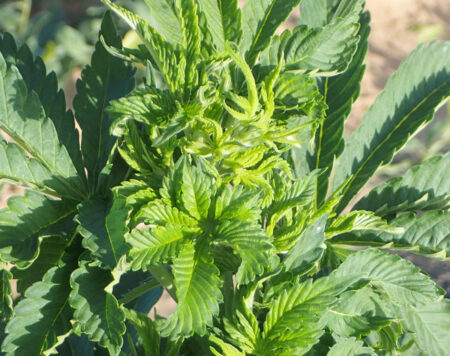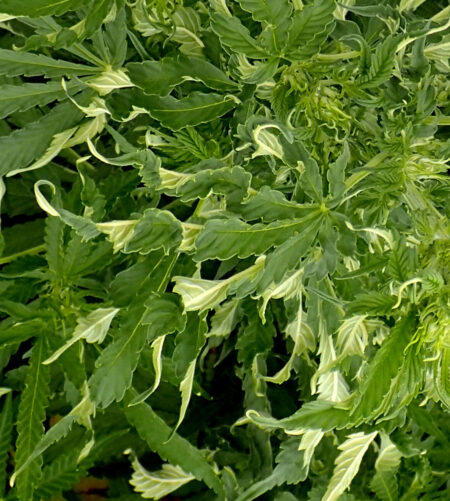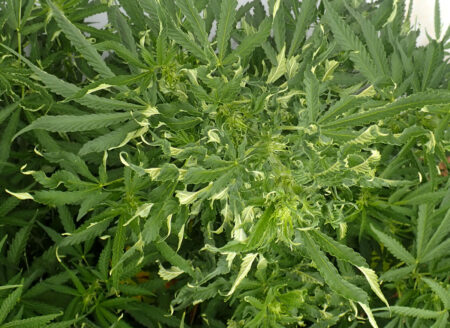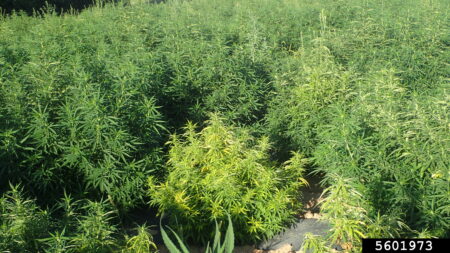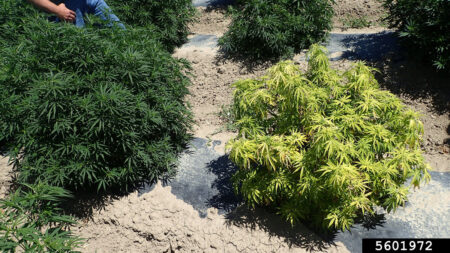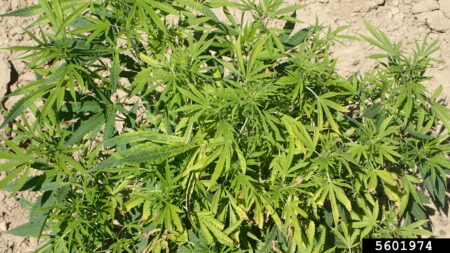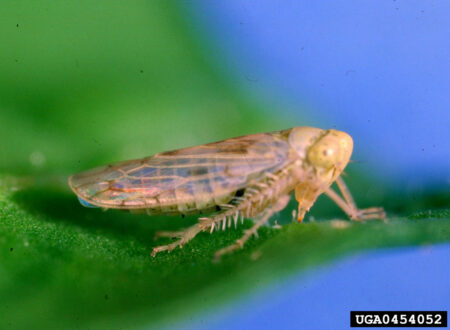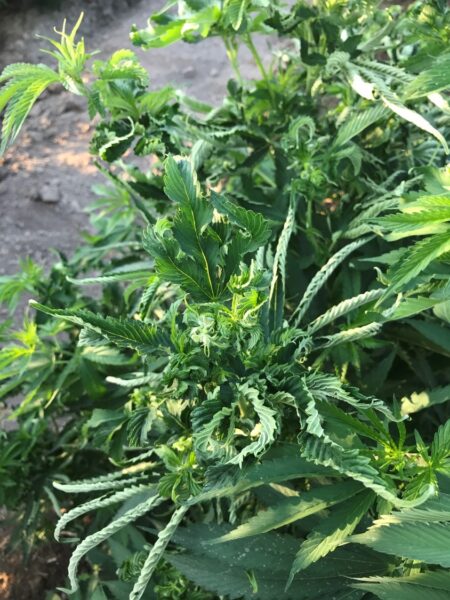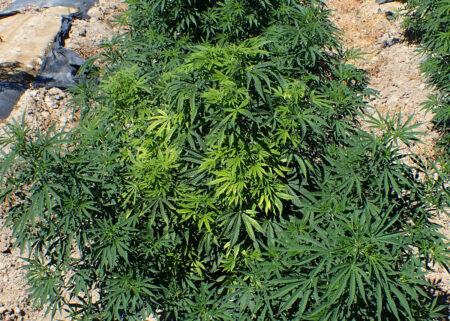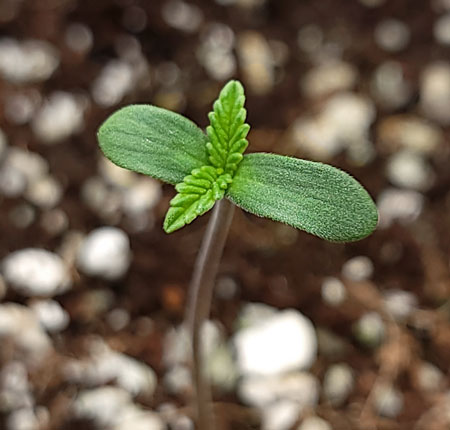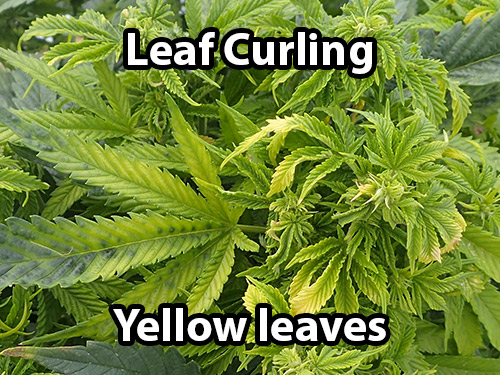
by Nebula Haze
This article on beet curly top virus in cannabis plants is largely based on the invaluable contributions of Whitney Cranshaw. Cranshaw has built an extensive repository on hemp pests and generously offers pest pictures and information to the cannabis-growing and scientific communities.
I would also like to thank Dr. Punya Nachappa, Judith Chiginsky, and Bob Hammon for contributing online resources on beet curly top virus in cannabis plants to help create a comprehensive information sheet [PDF] on the subject. For further reading, Colorado State University offers more excellent cannabis pest information sheets.
Pictures of Cannabis Plants with Beet Curly Top Virus
Some cannabis plants get yellow and stunted, but may not show the “curly top” symptoms. First, the “curly top” everyone’s talking about:
“Leaf curling associated with infection of hemp by beet curly top virus.” ~Whitney Cranshaw
“‘Classic’ symptoms of beet curly top virus infection of hemp, with generalized yellowing of the plant, without leaf distortion, and stunting.” ~ Whitney Cranshaw
Leafhoppers Spread Beet Curly Top Virus!
Check out the full page on leafhoppers (one of the leading vectors for beet curly top virus in cannabis plants).
The beet leafhopper is a host for Beet Curly Top Virus, and easily spreads the disease while feeding. Photographer: A.C. Magyarosy
It is possible other types of leafhoppers, or other insects, could be spreading the virus among marijuana plants, though more information is needed.
What is Beet Curly Top Virus and How Does it Infect Cannabis Plants?
Beet Curly Top Virus (BCTV) is a cannabis plant disease that is transmitted by the beet leafhopper (Neoaliturus tenellus) and possibly other forms of transmission (other bugs, transferring the virus from one plant to another during handling, etc).
Beet Curly Top Virus (BCTV) can infect a wide variety of host plants, including sugar beets, tomatoes, beans, spinach, and cannabis (hemp) plants. I heard about beet curly top virus at the Cannabis Business Conference in 2022, though it initially was identified in cannabis plants in 2020 or earlier.
“Beet curly top virus infection showing both yellowing and strong leaf curling.” ~Whitney Cranshaw
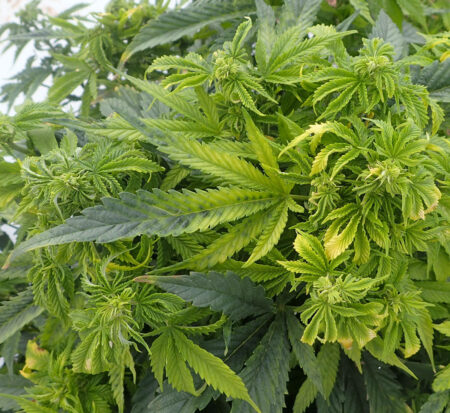
How the Virus Spreads to Cannabis Plants
Most commonly, the disease is spread through leafhoppers (a common cannabis pest), which feed on infected plants and then spread the virus to a clean plant on its next feeding.
So far, the Worland (BCTV-Wor) and Colorado (BCTV-CO) strains of the beet curly top virus have been identified in Colorado, but there are likely other strains affecting cannabis plants in different parts of the world.
Symptoms of Beet Curly Top Virus in Cannabis Plants
BCTV can cause a wide variety of symptoms, though the curling of new growth (“curly tops”) is the most striking.
- Twisting of new growth (“curly tops”) – New growth on the plant may display a strong twisting or curling pattern. This new growth may remain green or turn yellow. Leaves tend to curl upwards
- Stunted size – Slow growth is common, and plants may stay small or act like “runts” even if they don’t show other symptoms.
- Leaf yellowing or mottling – Early stages of infection may produce light yellowing or mottling, mostly at the base of a leaf. Over time, this yellowing may become more pronounced and eventually whole plays may become pale yellow and stunted
- Localized symptoms – Some plants may only have symptoms on certain spots, while the rest of the growth appears normal. For instance, the original stem might develop curly top symptoms, while side branches that develop later have typical growth patterns.
The total effects (overall health, yield, and other potential issues) of beet curly top virus on cannabis plants are still not fully understood, because the virus’ ability to affect cannabis plants was discovered relatively recently.
Some hemp or cannabis plants infected with the virus can outgrow most of these symptoms, but it’s still a good idea to get rid of them anyway to prevent future transmission. We need to do more research to discover all the strains affecting cannabis, and how they differ from each other.
“‘Bisymptomatic’ hemp plant infected with beet curly top. In this condition, the original plant stem shows strong symptoms of infection, including yellowing and leaf distortion. On the same plant, side shoots develop that appear symptom free.” ~Whitney Cranshaw.
How to Treat Beet Curly Top Virus (Prevention)
Unfortunately, because there is no cure for beet curly top virus, the best thing for a cannabis grower to do is get rid of all cannabis plants known to be infected by BCTV.
Note: It is possible to use plant tissue culture to grow a clone of the infected plant (typically done in a lab by experts), which gives you a clean uninfected plant with the same genetics. However, there is no way to cure a plant that already has the virus. Even if it outgrows its symptoms (which occasionally happens), it will still be able to infect other plants. Therefore it’s highly recommended to carefully dispose of infected plants.
- Carefully get rid of infected plants – If you suspect your plant has beet curly top virus, separate it immediately from your other plants, and consider throwing it away to prevent the potential spread of the virus to other plants.
- Get rid of leafhoppers (if any) – If you suspect your cannabis got infected due to leafhoppers, then a preventative step is to control the local leafhopper population.
- Clean entire grow area – Outdoors, clean the area around the plants (rake up any leaves, treat for bugs, etc.). Indoors, it’s a good idea to sterilize any part of the grow space that may have touched infected plant matter.
- Take care when touching plants – Until you’re during the virus is gone, take extra care whenever you’re touching one plant and then another. For example, if you’re defoliating or cutting off parts of the plant, make sure to change gloves before you start on another plant. You don’t want the juices from the inside of one plant to touch the inside of another plant.
- Start with seeds – Clones will typically carry the virus if the parent plant was infected, but cannabis plants grown from seeds are rarely infected (even if their parents were). Dip seeds briefly in a 10% hydrogen peroxide solution before germination to ensure the virus is not on the seed coat. This doesn’t prevent the plant from catching the virus later, but starting with seeds helps give you a small amount of protection because, without any infected plants around, transmission is impossible.
Protect your cannabis plants from viruses so they can focus on producing amazing buds.
Conclusion
In this tutorial, we’ve unearthed vital insights about the Beet Curly Top Virus (BCTV) and its bearing on cannabis plants. From its varied host plants to its symptoms and strains, BCTV is a formidable threat that requires keen observation and swift action.
Key takeaways for cannabis growers
- Understand the Virus – BCTV is a disease transmitted to cannabis plants by beet leafhoppers and possibly other means. Simply being aware of this and its many host plants prepares you to intervene swiftly when the first signs of infection appear.
- Spot the Symptoms – Identifying the symptoms of BCTV is crucial for early detection. Curling of new growth, stunted growth, leaf mottling or yellowing, and localized symptoms are key indicators of potential infection.
- Transmission – The primary transmission method is through leafhoppers or other mechanical damage (like pruning first an infected plant and then a healthy one without washing your hands between). Understanding how transmission works can guide you toward effective control measures, like carefully handling plants and managing leafhopper populations.
- Management and Control – Although there is no cure for BCTV, there are practical strategies for managing an outbreak. Disposing of infected plants, eradicating leafhoppers, thoroughly cleaning the grow area, and minimizing plant-to-plant contact can help curb the spread of the virus. If you’re concerned your current stock of genetics may have the virus, start your next grow with known clean plants (or seeds) to help ensure you have clean stock.
Remember, the best defense against BCTV is a strong offense. Stay vigilant, act quickly, and employ these strategies to safeguard healthy cannabis plants and yield. The journey to understanding and managing BCTV is ongoing, and your proactive efforts are a critical part of that process.
If you have pictures, information, or experience with beef curly top virus in cannabis plants, please don’t hesitate to contact us so we can help share the word!

